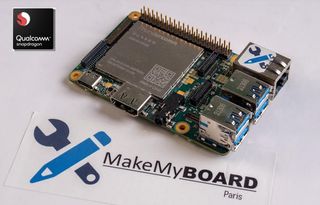The market is filled with Raspberry Pi clones that promise to be faster, cheaper or have more ports. However, most of these single-board computers use cheap processors from lower-end brands such as RockChip and Mediatek. A new player, the Thunderberry5, uses a Qualcomm Snapdragon chip, the same brand found in many major brand phones, tablets and Arm-powered laptops.
An upcoming board from French company MakeMyBoard, Thunderberry5 claims to be "the first Raspberry Pi-like SBC based on Qualcomm AI-CPU" and powering the show is a Qualcomm QCS610 Snapdragon. The Kryo 460 Octa-core CPU is powered by two Gold 2.2 GHz cores, and six Silver 1.8 GHz cores. That sounds like it would be faster than the 1.5 to 1.8-GHz CPU in the Raspberry Pi 4 B, but we wouldn't know for sure without testing.
The SoC's Qualcomm AI Engine (AI Stack and Neural Processing Engine) provides the power for general AI duties, making the board an interesting platform for machine learning and robotics. Graphics duties are carried out by an Adreno 612, clocked at up to 845 MHz. Thunderberry5 comes with 4GB of LPDDR4 RAM and 64GB of eMMC 5.1 on which the OS choices are currently Android 10 or Yocto embedded Linux.

The curveball with this board is the embedded RP2040 microcontroller. An embedded microcontroller isn't new. We have reviewed Seeed's Odyssey and LattePanda 3 Delta, each of which had an Intel CPU and an Arduino compatible Atmel microcontroller. But, this is the first board that we have come across to feature the RP2040 as an embedded microcontroller.
In the block diagram, we can see that the "RP4020" -- surely a typo for RP2040 -- is connected to a 2 x 20 pin header GPIO labelled "HAT_conn". We cannot ascertain if this is pin compatible with the best Raspberry Pi HATs and we have contacted the project creator for clarification. We can see in the block diagram that the RP2040 is baked into the board and uses a USB 2 to serial interface for communication. This means that it will appear as a device to the underlying Linux operating system.
| SoC | Qualcomm QCS610 Snapdragon |
| Row 1 - Cell 0 | Kryo 460: 64-bit Octa-cores, 2x Gold (2.2GHz) + 6x Silver (1.8GHz) |
| Row 2 - Cell 0 | GPU: Adreno 612 @ up to 845MHz |
| Row 3 - Cell 0 | AI: Qualcomm AI Engine / QUALCOMM AI STACK and Qualcomm® Neural Processing Engine SDK |
| RAM | LPDDR4 4GB |
| Storage | 64GB eMMC 5.1, |
| Display | HDMI 1.4 1920 x 1200 @ 60fps |
| Row 7 - Cell 0 | TFT DSI DPHY 1.2 2520 x 1080 @ 60fps |
| Video | Decode 4K30 HEVC/VP9 |
| Row 9 - Cell 0 | Encode 4k30 HEVC |
| Connectivity | Gigabit Ethernet |
| Row 11 - Cell 0 | 802.11a/b/g/n/ac Wi-Fi |
| Row 12 - Cell 0 | Bluetooth |
| Row 13 - Cell 0 | 4 x USB 3 |
| Row 14 - Cell 0 | USB C (5V power only) |
| Audio | Qualcomm WCD9341 codec |
| Row 16 - Cell 0 | +Qualcomm WSA8810 Speaker Amplifier 1W |
| Row 17 - Cell 0 | Headphone Jack |
| Sensors / Inputs | Microphone |
| Row 19 - Cell 0 | LSM6DSOTR Gyroscope / Accelerometer |
Other than the specs and some images, we don't know too much about this Raspberry Pi competitor, but we have contacted the creator to learn more about Thunderberry5. For now, the price and release date are a mystery, but we will update this story once we have more information.

